The Belt and Road Initiative and Connectivity Are Mutually Reinforcing
The Belt and Road Initiative and Connectivity Are Mutually Reinforcing*
November 8, 2014
Last fall I made a proposal on behalf of the Chinese government to build the Silk Road Economic Belt and the 21st Century Maritime Silk Road (the Belt and Road Initiative). The international community, and leaders present here in particular, have responded to the initiative positively. The initiative and the connectivity endeavor are compatible and mutually reinforcing. If the Belt and the Road are likened to the two wings of a soaring Asia, then connectivity represents its arteries and veins. With the implementation of the initiative now entering a stage of pragmatic cooperation, I wish to propose the following:
First, we should focus on Asian countries and realize connectivity in Asia first. The Belt and Road both trace their origins to Asia. They will find support in Asia and bring benefit to Asia. It is natural that we focus our attention on connectivity between Asian countries and strive to expand our common interests. The Belt and Road Initiative represents a joint undertaking by China and its Asian neighbors. China gives top priority to neighboring countries in its foreign policy and pursues amity, sincerity, mutual benefit and inclusiveness in building relations with them. China is ready to provide more public goods to its Asian neighbors through connectivity, and welcomes them to board China's train of development.
Second, we should develop a basic framework of Asian connectivity by leveraging economic corridors. Now, China has made a basic master plan for the Belt and Road Initiative. It includes the land and maritime economic corridors, which are still under development, on the basis of full consultation among all parties. The proposed framework should accommodate the needs of all relevant countries and cover both land and sea-related projects. The framework, once developed, will be both extensive and inclusive, and it will have far-reaching impacts. China is ready to engage in further consultation with the countries involved with a view to improving the blueprint and laying a more solid foundation for our cooperation.
Third, we should gather an early harvest in Asian connectivity by making breakthroughs in transport infrastructure. The Silk Road project begins with roads. With roads in place, people and goods can flow. China attaches great importance to the railway and highway projects linking China to Pakistan, Bangladesh, Myanmar, Laos, Cambodia, Mongolia, Tajikistan and other neighboring countries. These projects will be given priority in the planning and implementation of the Belt and Road Initiative. The more and the sooner people benefit from the initiative, the greater appeal and vigor the initiative will have.
Fourth, we should break through bottlenecks in Asian connectivity by building a financing platform. Most Asian countries are developing countries facing a shortage of funds for development. What is important is to use what is available effectively and spend the increment wisely, so that precious financial resources will be channeled to the most worthy projects. Here, I would like to announce that China has decided to commit US$40 billion to the establishment of a Silk Road Fund. This new fund is designed to provide investment and financing support to countries along the Belt and Road for connectivity projects such as infrastructure, resources development, and industrial and financial cooperation. The Silk Road Fund is an open fund which allows establishment of sub-funds by the region, sector or project. Investors from both within and outside of Asia are welcome to participate in the Fund.
Fifth, we should strengthen the social foundation for Asian connectivity by promoting people-to-people exchanges. China welcomes dialogue between civilizations and faiths, encourages exchanges between cultures and peoples among all countries, stands in favor of joint applications for World Cultural Heritage status by all countries along the Belt and Road, and wishes to see closer cooperation between local governments of provinces and cities in Asian countries. Asia boasts a wealth of resources in the field of tourism. As our citizens travel abroad in increasing numbers, we should incorporate the Silk Road into our tourism strategies and combine our cooperation in tourism with our efforts for better connectivity. Connectivity requires great numbers of professionals. In the coming five years, China will provide neighboring countries with training opportunities for 20,000 connectivity professionals in support of their efforts to cultivate their own experts. China is also ready to send more students and scholars to neighboring countries for studies and academic exchanges.
* Part of the speech at the Dialogue on Strengthening Connectivity Partnership.
(Not to be republished for any commercial or other purposes.)



